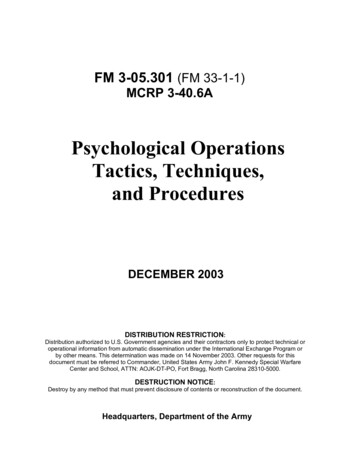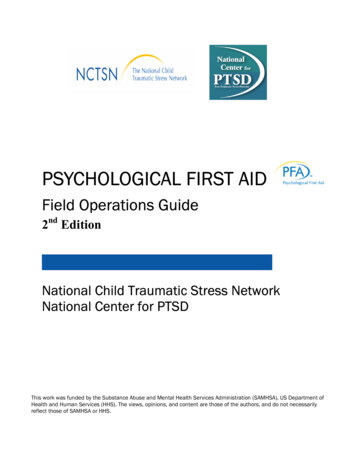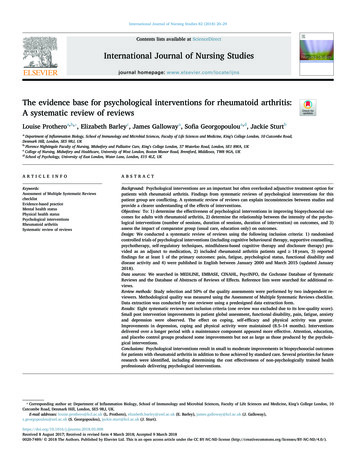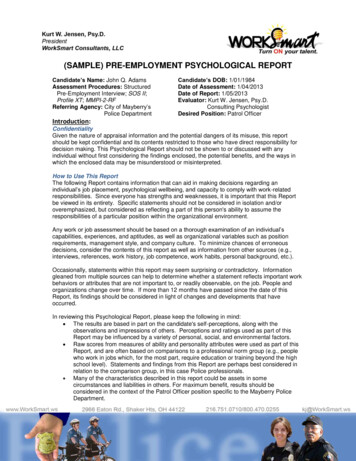
Transcription
FM 3-05.301 (FM 33-1-1)MCRP 3-40.6APsychological OperationsTactics, Techniques,and ProceduresDECEMBER 2003DISTRIBUTION RESTRICTION:Distribution authorized to U.S. Government agencies and their contractors only to protect technical oroperational information from automatic dissemination under the International Exchange Program orby other means. This determination was made on 14 November 2003. Other requests for thisdocument must be referred to Commander, United States Army John F. Kennedy Special WarfareCenter and School, ATTN: AOJK-DT-PO, Fort Bragg, North Carolina 28310-5000.DESTRUCTION NOTICE:Destroy by any method that must prevent disclosure of contents or reconstruction of the document.Headquarters, Department of the Army
*FM 3-05.301(FM 33-1-1)MCRP 3-40.6AHEADQUATERSDEPARTMENT OF THE ARMYField ManualNo. 3-05.301Washington, DC, 31 December 2003Psychological Operations Tactics,Techniques, and ProceduresContentsPagePREFACE . ivChapter 1OVERVIEW .1-1Full-Spectrum Operations .1-1PSYOP Missions .1-2PSYOP Functions .1-3PSYOP and Information Operations .1-4Summary .1-6Chapter 2COMMAND AND CONTROL OF PSYOP FORCES .2-1PSYOP Staff Officer or Noncommissioned Officer .2-1PSYOP Assessment Team .2-2PSYOP Support Element .2-4PSYOP Task Force .2-4DISTRIBUTION RESTRICTION: Distribution authorized to U.S. Government agencies and their contractors onlyto protect technical or operational information from automatic dissemination under the International ExchangeProgram or by other means. This determination was made on 14 November 2003. Other requests for thisdocument must be referred to Commander, United States Army John F. Kennedy Special Warfare Center andSchool, ATTN: AOJK-DT-PO, Fort Bragg, North Carolina 28310-5000.DESTRUCTION NOTICE: Destroy by any method that must prevent disclosure of contents or reconstruction ofthe document.Marine Corps distribution: PCN 14400013500*This publication supersedes FM 33-1-1, 5 May 1994.i
FM 3-05.301PageUse of Digital Systems by PSYOP Forces .2-25Summary .2-30Chapter 3INTELLIGENCE PREPARATION OF THE BATTLESPACE .3-1Four-Step PSYOP Intelligence Preparation of the Battlespace Process .3-2Area of Operations and the Battlespace: Implications for PSYOP .3-3PSYOP Intelligence Preparation of the Battlespace Products . 3-13Summary .3-16Chapter 4PSYOP PLANNING PROCESS .4-1Supported Unit Planning .4-1Operational Planning .4-25Summary .4-44Chapter 5TARGET AUDIENCE ANALYSIS .5-1Target Audience Analysis Process .5-1Summary .5-24Chapter 6PSYOP DEVELOPMENT .6-1PSYOP Development Center .6-2Phases of the PSYOP Development Process .6-11Summary .6-29Chapter 7EVALUATION OF PRODUCT EFFECTIVENESS .7-1Product Pretesting .7-1Impact Assessment and Posttesting .7-11Summary .7-14Chapter 8TACTICAL PSYOP FUNCTIONS AND ORGANIZATION .8-1Tactical PSYOP Battalion .8-1Tactical PSYOP Company .8-1Tactical PSYOP Detachment .8-6Operations Supported by Tactical PSYOP .8-32PSYOP Support to Army Special Operations Forces Core Tasks .8-35Summary .8-36Chapter 9PSYOP MEDIA PRODUCTION .9-1Production Process .9-1Organic Print Assets .9-1Nonorganic Print Assets .9-2ii
FM 3-05.301PageVisual Product Production . 9-2Audio and Audiovisual Assets . 9-11Contracted Production Assets . 9-20Other Production Assets . 9-20Summary . 9-21Chapter 10DISTRIBUTION AND DISSEMINATION OF PSYOP PRODUCTS . 10-1Distribution Methods . 10-1Dissemination Factors . 10-5Summary . 10-20Chapter 11PROPAGANDA ANALYSIS AND COUNTERPROPAGANDA . 11-1Terminology . 11-1Counterpropaganda Process . 11-4Summary . 11-26Chapter 12PSYOP SUPPORT TO INTERNMENT/RESETTLEMENT . 12-1Mission . 12-1Mission-Essential Tasks . 12-1Operational Concepts and Procedures . 12-2Internment/Resettlement Detachment . 12-2Summary . 12-10Appendix APSYOP AND THE TARGETING PROCESS . A-1Appendix BRESERVE MOBILIZATION . B-1Appendix CPSYOP MAPPING SYMBOLS .C-1Appendix DADVERTISING AND SOCIAL MARKETING .D-1Appendix ETRIP REPORT FORMAT . E-1Appendix FAFTER ACTION REPORT FORMAT . F-1Appendix GPRODUCT NUMBERING COUNTRY CODES . G-1Appendix HUSE OF INTERPRETERS .H-1Appendix IPSYOP IN SUPPORT OF STABILITY OPERATIONS . I-1Appendix JPSYOP IN SUPPORT OF UNCONVENTIONAL WARFARE . J-1Appendix KLEAFLET OPERATIONS . K-1Appendix LWEIGHTS, MEASURES, AND CONVERSION TABLES . L-1GLOSSARY . Glossary-1BIBLIOGRAPHY .Bibliography-1INDEX . Index-1iii
PrefaceField Manual (FM) 3-05.301 presents tactics, techniques, and procedures forimplementing United States (U.S.) Army Psychological Operations (PSYOP) doctrinein FM 3-05.30, Psychological Operations. FM 3-05.301 provides general guidance forcommanders, planners, and PSYOP personnel who must plan and conduct effectivePSYOP across the full spectrum of operations. This manual also provides guidance forPSYOP personnel to accomplish a broad range of missions successfully, using thelatest organizational structure, terminology, and capabilities.FM 3-05.301 is a guide, not a regulation. As such, the tactics, techniques, andprocedures it presents should not limit creativity or imagination, provided thatthey adhere to Army doctrine, U.S. national policy, and the commander’s intent.The targeted user of this manual is primarily the PSYOP community. Written togive PSYOP officers, noncommissioned officers (NCOs), enlisted Soldiers, andcivilians standardized PSYOP doctrine, FM 3-05.301 is a comprehensive how-tomanual, focusing on critical PSYOP tasks, duties, and responsibilities.This manual describes procedures and provides templates for conducting the fivePSYOP missions and seven PSYOP functions in a systematic, chronologicalfashion. Its organization generally follows the PSYOP development process, fromplanning through execution.This manual contains numerous acronyms, abbreviations, and terms. Usersshould refer to the Glossary at the back of this manual for their meaningsor definitions.The proponent of this manual is the United States Army John F. KennedySpecial Warfare Center and School (USAJFKSWCS). Submit comments andrecommended changes to Commander, USAJFKSWCS, ATTN: AOJK-DT-PO,Fort Bragg, NC 28310-5000.Unless this publication states otherwise, masculine nouns and pronouns do notrefer exclusively to men.This manual does not implement any international standardization agreements(STANAGs).iv
Chapter 1OverviewAll military action is intertwined with psychological forces and effects.Carl von ClausewitzOn War, 1827PSYOP are planned operations that convey selected information andindicators to foreign target audiences (TAs) to influence their emotions,motives, objective reasoning, and ultimately, the behavior of foreigngovernments, organizations, groups, and individuals. The purpose of allPSYOP is to create in neutral, friendly, or hostile foreign groups theemotions, attitudes, or desired behavior that support the achievement ofU.S. national objectives and the military mission. In doing so, PSYOPinfluence not only policy and decisions, but also the ability to govern, theability to command, the will to fight, the will to obey, and the will tosupport. The combination of PSYOP products and actions create in theselected TAs a behavior that supports U.S. national policy objectives andthe theater commander’s intentions at the strategic, operational, andtactical levels.The nature of PSYOP is varied and ever changing. PSYOP personnelmust support a broad range of missions and force structures inenvironments ranging from austere to highly sophisticated. PSYOP areplanned, coordinated, and executed before, during, and after conflicts,and must be integrated at all echelons to achieve its full force-multiplierpotential.A force multiplier of special operations forces (SOF), PSYOP forces areassigned to the United States Special Operations Command(USSOCOM), based on the 1986 Goldwater-Nichols Department ofDefense (DOD) Reorganization Act. PSYOP units deploy to conductmissions in support of geographic combatant commanders and theirsubordinate joint task force (JTF) and component commanders. PSYOPforces may also support U.S. Ambassadors, allies, alliance and coalitionpartners, and other government agencies (OGAs).FULL-SPECTRUM OPERATIONS1-1. PSYOP are conducted in military operations other than war (MOOTW)and war (Figure 1-1, page 1-2), and are key contributors to shaping theinternational security environment and reacting to events. PSYOP areinherently joint and frequently combined operations. They support joint,1-1
FM 3-05.301interagency, multinational, conventional, and special operations (SO) forces.Army PSYOP forces are organized, equipped, and trained to provide strategic,operational, and tactical support to the theater combatant commanders. PSYOPsupport all missions across the full spectrum of operations.Figure 1-1. Full-Spectrum Operations1-2. Proven in combat and peacetime, PSYOP are one of the oldest weaponsin the arsenal of man, as well as an important force protector, combatmultiplier, and nonlethal weapons system. Effective use and employment ofPSYOP forces provides many capabilities that facilitate successful missionaccomplishment. The following are examples: Project a favorable image of U.S. and allied forces. Inform TAs in new or denied areas. Amplify the effects of a show-of-force. Give TAs alternative courses of action (COAs). Overcome censorship, illiteracy, or interrupted communications. Exploit ethnic, cultural, religious, or economic differences.PSYOP MISSIONS1-3. PSYOP are conducted at the strategic, operational, and tactical levels ofwar to influence foreign audiences. PSYOP forces provide a nonlethalcapability in conveying information to selected TAs and governments toinfluence their emotions, motives, objective reasoning, and behavior. PSYOPSoldiers perform the following five principal missions to meet the intent ofthe supported commander: Advise the commander on Psychological Operations actions (PSYACTs),PSYOP enabling actions, and targeting restrictions that the militaryforce will execute. These actions and restrictions minimize adverseimpacts and unintended consequences, attack the enemy’s will toresist, and enhance successful mission accomplishment.1-2
FM 3-05.301 Influence foreign populations by expressing information subjectively toinfluence attitudes and behavior, and to obtain compliance ornoninterference. These actions facilitate military operations, minimizeneedless loss of life and collateral damage, and further the objectives ofthe United States and its allies. Provide public information to foreign populations to supporthumanitarian activities, restore or reinforce legitimacy, ease suffering,and maintain or restore civil order. Serve as the supported commander’s voice to foreign populations toconvey intent and establish credibility. Counter enemy propaganda, misinformation, disinformation, andopposing information to portray friendly intent and actions correctlyand positively, thus denying others the ability to polarize publicopinion and political will against the United States and its allies.PSYOP FUNCTIONS1-4. To conduct the five PSYOP missions effectively and efficiently, PSYOPunits perform seven functions. These functions include the following: Perform command, control, communications, computers, andintelligence (C4I) functions. C4I is the exercise of authority anddirection over assigned PSYOP forces when accomplishing theirmissions. A PSYOP commander performs this function by arrangingpersonnel, equipment, communications, supplies, facilities, andprocedures when planning, directing, coordinating, and controllingPSYOP. PSYOP forces play a unique role in the intelligence function.They are both a producer and a consumer. PSYOP forces have theability to collect, process, integrate, analyze, and evaluate relevantinformation for their own use and for use by the supported commander,OGAs, and other intelligence organizations. Develop PSYOP plans, programs, supporting programs, series, andproducts. Development involves the selection of PsychologicalOperations objectives (POs) and supporting Psychological Operationsobjectives (SPOs), the conceptualization of multiple series, theconstruction of specific product prototypes, as well as therecommendation of actions to influence the beliefs of selected TAs tomodify their behavior. This function consists of detailed coordinationbetween various PSYOP elements involving target audience analysis(TAA), series development, product prototype development, approvalprocess review, and evaluation before and after dissemination tomeasure PSYOP effectiveness. Produce PSYOP media. Production is the transformation of approvedPSYOP product prototypes into various media forms that arecompatible with the way foreign populations are accustomed toreceiving information. Some production requirements may becontracted to private industry, while other requirements may beperformed by units attached or under the tactical control (TACON) oroperational control (OPCON) of the PSYOP forces.1-3
FM 3-05.301 Distribute PSYOP products. Distribution is the movement of completedproducts from the production source to the point where disseminatorsare located. This function may include the temporary storage of PSYOPproducts at an intermediate location. Depending on the type of product,this can be done either physically or electronically. PSYOP forces mustmake full use of organic equipment, commercial assets, and resourcesof other Services to facilitate the distribution process. PSYOP plannersshould attempt to simplify distribution and ensure alternative andcontingency techniques whenever possible. Disseminate PSYOP products. Dissemination involves the delivery ofPSYOP products directly to the desired TA. PSYOP forces mustleverage as many different media and dissemination means as possibleto ensure access to the targeted foreign population. Employ tactical PSYOP. Tactical PSYOP forces provide PSYOPfunctions on a reduced and limited scale to a supported tacticalcommander within a designated area of operations (AO). These forcesare sometimes the supported tactical commander’s only link withindigenous populations. Tactical PSYOP forces also collect relevantinformation for use by developers and the supported commander. Conduct internment/resettlement (I/R) operations. In virtually allsituations where military forces are used, the management of interneesbecomes an integral part of the operation. PSYOP forces dispel rumors,create dialogue, and pacify or indoctrinate internees to minimizeviolence, facilitate efficient camp operations, and ensure safe andhumanitarian conditions persist. This function also complements otherPSYOP tasks through testing of materials, assessing the culture ofpotential audiences, collecting information and processing intelligence,and recruiting key communicators, informants, and collaborators.PSYOP AND INFORMATION OPERATIONS1-5. Information operations (IO) are actions taken to influence adversaryinformation and information systems while defending one’s own informationand information systems. IO are conducted at all levels of war, across allphases of an operation, and across the conflict spectrum. PSYOP function notonly as an integral capability of IO but also as a leverage for IO activities andcapabilities. PSYOP are, therefore, a user of IO capabilities and technologiesand a contributor to the overall IO effort of the supported command.INFORMATION OPERATIONS SUPPORT TO PSYOP1-6. Joint and Service-specific IO support elements and organizations offerthe following capabilities and technologies that enhance and facilitate PSYOPin support of a commander: Databases and links to other Services and to OGAs that can providealternate distribution or dissemination means and intelligence supportto PSYOP forces. Access to organizations that conduct media, propagation, and spectrumanalysis, as well as modeling.1-4
FM 3-05.301 Systems and links to facilitate the collection of PSYOP impactindicators. Access to organizations that provide critical personality profiling andhuman factor analysis.FM 3-05.30 provides a detailed discussion of joint and Service-specific IOorganizations and their capabilities.PSYOP AS A CONTRIBUTOR TO INFORMATION OPERATIONS1-7. Just as IO can enhance and facilitate PSYOP, PSYOP can contribute tothe achievement of a supported commander’s IO objectives. PSYOP personnelassigned or attached to a supported command—working in the J-3 (joint),G-3/G-7 (Army corps/division), or S-3 (brigade/battalion)—coordinate, synchronize, and deconflict PSYOP with IO. They participate through continuouscoordination and liaison as staff members at all levels on the staff ofsupported commands; such as an IO cell, plans group, and targetingmeetings. PSYOP personnel advise the supported commander on all aspectsof PSYOP and recommend PSYACTs and PSYOP enabling actions. PSYOPsupport IO by— Influencing foreign populations by expressing information subjectivelyto change attitudes and behavior and to obtain compliance ornoninterference. Providing feedback on the effectiveness of IO activities. PSYOPpersonnel can collect information in the performance of assigned dutiesthat, although not specifically related to PSYOP, may indicateeffectiveness in another aspect of a supported command’s IO plan. Forexample, an IO objective may be to gain the confidence and trust of thelocal populace. PSYOP personnel might observe civilians within a jointoperations area (JOA) or an area of responsibility (AOR) using U.S. orcoalition medical facilities, rather than those provided by an adversaryor competing force. This preference may indicate that the civilianstrust U.S. or coalition forces for medical care, rather than trust theadversary for that care. Conducting PSYOP to support the commander’s IO objectives. Forexample, an IO objective may include denying certain frequenciesto adversaries. PSYOP platforms can broadcast on these frequenciesand effectively deny their use to adversaries amplifying the effect ofIO efforts. For example, PSYOP can publicize the efforts of CAactivities, such as medical programs, engineering projects, andfacilities restoration.1-8. Usually the combatant commander, the commander of the joint taskforce (CJTF), or the Service component commanders establish a cell tofacilitate the IO process. This cell usually has representatives for everycapability and related activity of IO. PSYOP representatives to the IO cellmay come from assigned PSYOP officers to the unified command1-5
FM 3-05.301headquarters (HQ) or as liaison officers from the Psychological Operationssupport element (PSE) or POTF. The PSYOP representative in the IO cellperforms the following functions: Integrates PSYOP with IO plans. Coordinates PSYOP support from the POTF. Deconflicts PSYOP plans and missions with IO plans and missions. Serves as liaison for information flow from the POTF to the supportedIO cell. Provides feedback on PSYOP missions to the IO cell.IO cell support to the POTF— Provides fused, tailored intelligence data and support. Ensures the joint targeting coordination board (JTCB) supports PSYOPtargeting considerations and requirements. Augments dissemination of PSYOP products through nonstandarddissemination platforms. Facilitates PSYOP planning by coordinating resources to support PSYOP.Figure 1-2, page 1-7, is an example of an IO cell.1-9. PSYOP and IO are mutually supportive and beneficial. Each enhancesthe other’s capability and mission effectiveness. Full integration and synergyof PSYOP and IO activities must occur to maximize their effect. This synergyof activities ensures consistency of message and optimizes credibility.Because of its complexity and inherent risks, PSYOP must be planned,conducted, and represented on staffs by PSYOP personnel. Additionally,because PSYOP are the commander’s voice to approved TAs in the JOA,PSYOP require routine and direct access to the commander. Ideas, thoughts,and messages disseminated by PSYOP forces include nuances whose impactsknow no borders and know no end. Direct access to the supported commanderensures that his intent for PSYOP is not diluted in translation bycoordinating staff officers or staff members, and that he is aware of theimpact of such ideas, thoughts, and messages within his JOA or AOR onplanned operations.SUMMARY1-10. PSYOP increase the relative combat power of friendly forces andadversely affect the combat power of the adversary. PSYOP accomplish thisresult by targeting the identified vulnerabilities of foreign audiences throughthe employment of the PSYOP development process. Within the DOD, theArmy has the primary military role to conduct PSYOP. Army PSYOP unitsperform this role by supporting U.S. national policy, by conducting PSYOP insupport of military operations and United States Government (USG)agencies, and by providing PSYOP training, advice, and assistance to U.S.forces and to friendly nations.1-6
FM 3-05.301Figure 1-2. Joint IO Cell Organization (Notional)1-7
Chapter 2Command and Control of PSYOP ForcesThe bravest are surely those who have the clearest vision of what isbefore them, glory and danger alike, and yet notwithstanding, go outto meet it.ThucydidesGreek Historian, 401 B.C.This chapter discusses command relations between PSYOP forces andsupported commanders. It covers the duties, functions, and responsibilities of PSYOP elements providing support to commanders, as well asthe general duties of liaison personnel. PSYOP forces at all levels usedigital tools to exercise command and control (C2) of subordinate units.Digital systems are the information exchange and decision supportsubsystems within the C2 support system of the total force.PSYOP STAFF OFFICER OR NONCOMMISSIONED OFFICER2-1. The PSYOP staff officer or NCO provides expertise within theappropriate staff element at the component command or unified command. Atthe Army corps and division level, the Deputy Chief of Staff (DCS), G-7 IO, isresponsible for coordinating and synchronizing the element of IO. At theunified command level and other than Army Service component level, IO andits elements are coordinated in the IO cell within the J-3 or G-3. The PSYOPstaff officer or NCO plans, coordinates, validates, and reports PSYOP forcedeployments theaterwide in response to the Secretary of Defense (SecDef),the joint staff, and other operational and contingency requirements. The staffofficer or NCO performs duties in the respective unified command’s jointoperations center (JOC), when required. He reviews and prepares detailedmessages, special reports, and briefings as required by the J-3 director andthe combatant commander, and provides functional expertise in joint PSYOPcapabilities and doctrine. The staff officer or NCO integrates directly with theJ-3 or G-3/G-7 staff and ensures PSYOP inclusion and integration. Hisprincipal duties include the following: Applies SO imperatives in PSYOP mission planning and execution. Assists and makes recommendations to the commander and staff onPSYOP matters and requirements for staff augmentation. Conducts mission analysis and the PSYOP portion of the intelligencepreparation of the battlespace (IPB). Prepares the appropriate PSYOP portions of the operation plan(OPLAN) and operation order (OPORD). Coordinates with supporting PSYOP units. Identifies PSYOP information requirements (IRs).2-1
FM 3-05.301 Nominates targets for lethal and nonlethal fires (Appendix A discussesPSYOP and the targeting process). Integrates PSYOP with other elements of the effects coordination cell(ECC) to achieve a synergistic effect. Promulgates PSYOP themes to stress and avoid throughout the command. Refines and updates POs and SPOs during planning. Integrates directly with the J-3 or G-3 staff and ensures PSYOPinclusion and integration. Maintains communication with the Psychological Operations task force(POTF) HQ. Reviews PSYOP standing OPLANs and participates in deliberate andcrisis-acti
operational, and tactical support to the theater combatant commanders. PSYOP support all missions across the full spectrum of operations. Figure 1-1. Full-Spectrum Operations 1-2. Proven in combat and peacetime, PSYOP are one of the oldest weapons in the arsena










